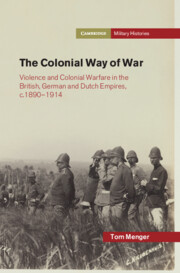Refine search
Actions for selected content:
3 results

The Colonial Way of War
- Violence and Colonial Warfare in the British, German and Dutch Empires, c.1890–1914
-
- Published online:
- 04 September 2025
- Print publication:
- 21 August 2025
5 - Practices of Violence
-
- Book:
- The Colonial Way of War
- Published online:
- 04 September 2025
- Print publication:
- 21 August 2025, pp 239-305
-
- Chapter
- Export citation
1 - ‘The Centrality of Dispossession’
- from Part I - Settler Colonialism
-
-
- Book:
- The Cambridge World History of Genocide
- Published online:
- 23 June 2023
- Print publication:
- 04 May 2023, pp 23-45
-
- Chapter
- Export citation
